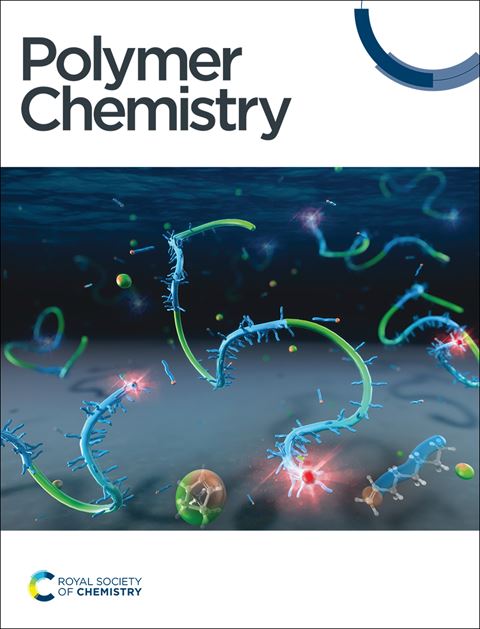具有可编程结构和可调性能的含亚胺聚酯的可持续一锅合成
IF 3.9
2区 化学
Q2 POLYMER SCIENCE
引用次数: 0
摘要
可持续地生产各种材料化学结构明确的热塑性塑料仍然具有挑战性。本文报道了一种新的氨基二醇/二羧酸双组分体系或氨基二醇/二醇/二羧酸三组分体系,利用热力学亚胺环和酯的形成,通过一锅熔融缩聚合成具有侧链亚胺基的热塑性聚酯的方法。与传统的三官能团体系不同,氨基二醇的氨基完全转化为亚胺而不需要交联。该方法的灵感来自于氨基醇和二羧酸通过熔融缩合反应生成二(酯亚胺)的模型反应,其中酯化、亚胺化和分子链传播机制可以扩展到聚合。结果表明,该系列含亚胺聚酯的重量-平均分子量可控制在110.8 kDa,玻璃化转变温度范围宽(- 24.6 ~ 115.4℃),机械性能可调,抗拉强度范围为8.0 ~ 34.5 MPa,断裂伸长率可达472%。可编程一锅合成技术在可持续和功能性材料方面具有广泛的潜力。本文章由计算机程序翻译,如有差异,请以英文原文为准。

Sustainable one-pot synthesis of imide-containing polyesters with programmable structures and tunable performance†
Sustainably producing thermoplastics with well-defined structures across various material chemistries remains challenging. Herein, we report a new synthetic methodology for thermoplastic polyesters with side-chain imide groups via one-pot melt polycondensation enabled by thermodynamic imide ring and ester formation, using either a two-component system of amino diol/dicarboxylic acid or a three-component system of amino diol/diol/dicarboxylic acid. Unlike traditional trifunctional systems, the amino groups of amino diols are fully converted into imide without cross-linking. This methodology was inspired by the model reaction of amino alcohol and dicarboxylic acid to form di(ester imide) via melt condensation, where the esterification, imidization and molecular chain propagation mechanisms can be extended to polymerization. The resulting series of imide-containing polyesters exhibited controllable weight-average molecular weights up to 110.8 kDa, a wide range of glass transition temperatures (−24.6 to 115.4 °C), and tunable mechanical properties with ultimate tensile strengths ranging from 8.0 to 34.5 MPa and elongations at break up to 472%. The programmable one-pot synthesis technology has extensive potential for sustainable and functional materials.
求助全文
通过发布文献求助,成功后即可免费获取论文全文。
去求助
来源期刊

Polymer Chemistry
POLYMER SCIENCE-
CiteScore
8.60
自引率
8.70%
发文量
535
审稿时长
1.7 months
期刊介绍:
Polymer Chemistry welcomes submissions in all areas of polymer science that have a strong focus on macromolecular chemistry. Manuscripts may cover a broad range of fields, yet no direct application focus is required.
 求助内容:
求助内容: 应助结果提醒方式:
应助结果提醒方式:


